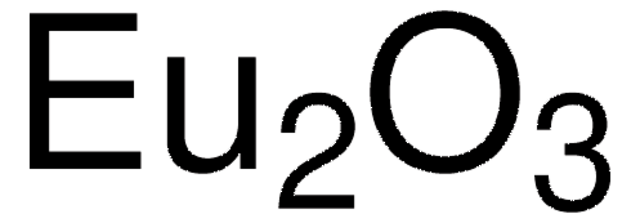207918
Europium(III) nitrate pentahydrate
99.9% trace metals basis
Synonym(s):
Europium trinitrate hydrate
About This Item
Recommended Products
Quality Level
assay
99.9% trace metals basis
form
crystals and lumps
reaction suitability
reagent type: catalyst
core: europium
impurities
≤1500.0 ppm Trace Rare Earth Analysis
SMILES string
O.O.O.O.O.[Eu+3].[O-][N+]([O-])=O.[O-][N+]([O-])=O.[O-][N+]([O-])=O
InChI
1S/Eu.3NO3.5H2O/c;3*2-1(3)4;;;;;/h;;;;5*1H2/q+3;3*-1;;;;;
InChI key
BBGDGFQCQRFYCP-UHFFFAOYSA-N
Looking for similar products? Visit Product Comparison Guide
Related Categories
General description
Application
- As a precursor to synthesize Y2O3:Eu3+ thin-film phosphors by sol-gel method for display applications.
- As a dopant to prepare crystalline nanophosphors. These are suitable for bioimaging as they are hydrophilic in nature and white light-emitting diodes.
- To fabricate dye-sensitized solar cells with enhanced light-harvesting efficiency.
- As a dopant to prepare various metal oxide nanoparticles, for example, ZnO nanoparticles for photocatalytic application.
signalword
Danger
hcodes
Hazard Classifications
Eye Irrit. 2 - Ox. Sol. 2 - Skin Irrit. 2 - STOT SE 3
target_organs
Respiratory system
Storage Class
5.1B - Oxidizing hazardous materials
wgk_germany
WGK 3
flash_point_f
Not applicable
flash_point_c
Not applicable
ppe
dust mask type N95 (US), Eyeshields, Gloves, type P3 (EN 143) respirator cartridges
Choose from one of the most recent versions:
Already Own This Product?
Find documentation for the products that you have recently purchased in the Document Library.
Customers Also Viewed
Articles
Spectral conversion for solar cells is an emerging concept in the field of photovoltaics, and it has the potential to increase significantly the efficiency of solar cells. Lanthanide ions are ideal candidates for spectral conversion, due to their high luminescence efficiencies and rich energy level structure that allows for great flexibility in the upconversion and downconversion of photons in a wide spectral region (NIR-VIS-UV).
The rare earth elements impact nearly everyone in the world. All of the people living in advanced technological countries and almost all those living in third world countries utilize the rare earths in their everyday living—the car that one drives (gasoline is refined from oil using rare earth catalysts and catalytic converters reduce the polluting emissions from the automotive exhaust), watching the news on TV (the red and green colors in TV screens), the telephones and computers we use to communicate (the permanent magnets in speakers and disc drives), just to name a few examples.
Our team of scientists has experience in all areas of research including Life Science, Material Science, Chemical Synthesis, Chromatography, Analytical and many others.
Contact Technical Service















